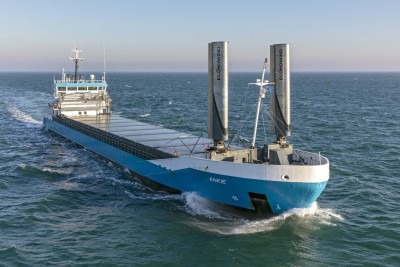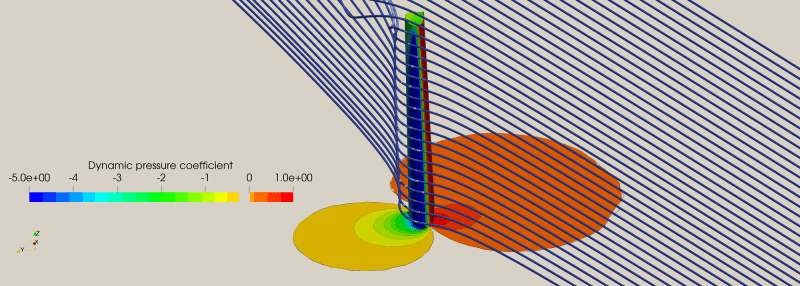Wind Assisted Ship Propulsion (WASP) is one of the methods available to help the shipping world reduce its reliance on (fossil) fuel and thereby enable a zero emission future. Of course this goes together with simply saving energy through measures such as having the main dimension and hull form optimised for actual operational conditions, efficient operations, and alternative carbon free or carbon neutral fuels. Each of these can also be applied to make gradual steps to achieve the final goal.
MV Ankie, subject vessel for the MIIP project. Courtesy eConowind
Despite promising results from various past studies, the uptake has been quite slow. However in recent years, we’ve seen more and more market introductions. Among the market-ready solutions the Flettner rotor is still dominant, although we are now seeing other solutions emerge such as suction sails, retractable wing sails and even kites are making a comeback.
Research at MARIN
To best catch the wind during this uptake, MARIN still sees potential for increased understanding, better predictions and better designs and operations. Firstly, the WiSP Joint Industry Project is in full swing. In this JIP the necessary methods to predict wind assistance performance are being studied, while at the same time, the rules and regulations are analysed. Additionally specific technical topics are addressed, such as the vortices that are generated when sailing at a leeway angle and that are passing through the propeller plane angle[1]. As well as this, the manoeuvring and seakeeping performance of wind assisted ships is being considered[2].
Finally, we’re looking at methods for optimising main dimensions, hull shape, and appendages (see MARIN Report 125, Wind Assisted Ship Propulsion design explorations).
Aerodynamic aspects
From research efforts by MARIN and other parties, the importance of aerodynamic aspects has become evident. The realistic wind field has a great influence on the final performance of the system as a whole. Interaction effects between WASP units, the influence of the ship’s structure, and the actual distribution of the wind profile (atmospheric boundary layer) are all factors that require consideration in the prediction stage.
Usually, during in-service performance evaluations, wind measurements are only taken at one location on the vessel. This point measurement leaves the analyst to use a theoretical boundary layer assumption, and also does not allow for the investigation of the interaction effects at different locations.
New initiatives
To allow us to carry out a more detailed evaluation of the in-situ wind field, MARIN has invested in new measurement technology, the latest addition being a wind scanner Lidar. This enables a high-fidelity, 3D undisturbed wind field to be resolved from a single measurement device. Within a MIIP project[3], MARIN will perform a measurement campaign on board the MV Ankie, a coastal freighter equipped with eConowind’s Ventifoils.
Representing the first use of such a wind scanning Lidar on board a vessel, this data will be key to achieving a proper assessment of the real-world performance of innovative wind-assisted solutions. This will open up possibilities for new validation efforts, and ultimately better predictions of WASP performance.
After this first campaign, MARIN aims to start a new Joint Industry Project focusing on the performance evaluation of windassisted solutions. Within this project, the main objective will be to increase our knowledge of the real-world performance by performing high-fidelity measurements, including the 3D wind field.
Visualisation of airflow streamlines and dynamic pressure coefficient distribution along free standing Ventifoil
[1] J.J.A. Schot and R. Eggers, “The Effect of Leeway Angle on the Propeller Performance”, International Conference on Wind Propulsion, London, United Kingdom, Oct. 2019. [2] R. Eggers and A.S. Kisjes, “Seakeeping and Manoeuvring for Wind Assisted Ships”, presented at the International Conference on Wind Propulsion, London, United Kingdom, Oct. 2019. [3] The MIIP project is supported by St. Nederland Maritiem Land and the Dutch Ministry of Economic Affairs and Climate Policy


